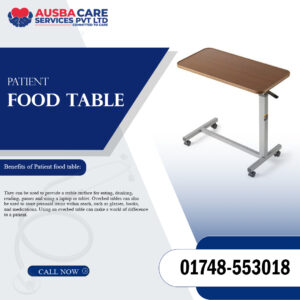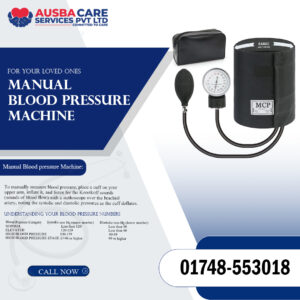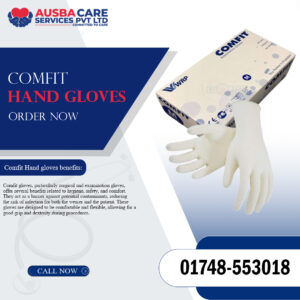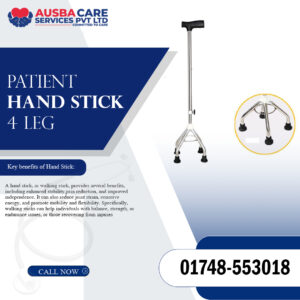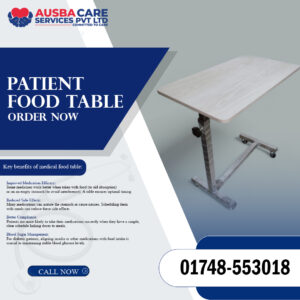Description
Everything You Need to Know About Patient Walkers: A Guide to Mobility, Independence, and Safety
Mobility challenges can arise from a variety of causes—aging, surgery, injury, or chronic medical conditions. For individuals experiencing difficulty walking, maintaining independence and safety becomes a daily concern. One of the most trusted mobility aids available today is the patient walker. Designed to offer support, balance, and increased mobility, patient walkers play a crucial role in enhancing the quality of life for many people.
In this article, we’ll explore the different types of patient walkers, their benefits, how to choose the right one, and tips for safe usage.
What Is a Patient Walker?
A patient walker is a mobility aid designed to assist individuals who have trouble walking unassisted. Typically made of lightweight metal, it consists of a sturdy frame with handles that the user grips for support. Most walkers have rubber tips or wheels at the base of the legs to provide stability and smooth movement.
Unlike canes or crutches that offer limited support, a walker distributes body weight evenly across four points, providing a stable platform to lean on. Walkers are commonly used by the elderly, individuals recovering from surgeries such as hip or knee replacements, and people with neurological conditions that affect balance.
Types of Patient Walkers
There are several types of patient walkers available, each designed to meet different needs:
1. Standard Walker (Non-Wheeled)
A basic model with four legs and no wheels. The user must lift and move the walker forward with each step. Best for those who need maximum support and can manage the physical effort of lifting the device.
2. Two-Wheeled Walker
This version has wheels on the front two legs and rubber stoppers on the back legs. It allows a smoother glide without needing to lift the walker entirely off the ground, making it easier on the arms and shoulders.
3. Four-Wheeled Walker (Rollator)
Equipped with four wheels, a hand brake, and often a built-in seat, the rollator is ideal for individuals who can walk but need occasional support. It is perfect for longer walks or outdoor use.
4. Hemi Walker
Designed for people with limited or no use of one hand or arm. A hemi walker is lighter and smaller, offering more support than a cane but easier to maneuver than a full-sized walker.
5. Folding Walkers
Most walker models are foldable for convenience. These are great for travel or when space is limited at home.
Benefits of Using a Patient Walker
Patient walkers do more than just provide physical support. Their benefits extend to emotional well-being and overall lifestyle improvements.
🔹 Improved Safety
Walkers reduce the risk of falls by offering a stable platform. This is especially important for seniors or individuals with balance issues.
🔹 Increased Independence
By enabling users to walk on their own, patient walkers help maintain a sense of autonomy and dignity. Users can complete daily tasks with less need for constant assistance.
🔹 Faster Recovery
Post-surgery patients recover more efficiently when they can move safely. Walkers encourage movement while reducing strain on healing joints or muscles.
🔹 Pain Reduction
Proper support reduces pressure on lower limbs, joints, and the spine, making walking less painful.
🔹 Emotional Confidence
Knowing that there is a support device available can reduce anxiety and increase confidence in mobility.
Choosing the Right Walker
Selecting the correct patient walker is crucial for comfort, safety, and effectiveness. Here are key factors to consider:
✅ Physical Condition
Consider the user’s strength, endurance, and balance. For example, someone with strong upper-body strength may do well with a standard walker, while someone with arthritis may prefer a rollator with a seat.
✅ Walker Height
✅ Indoor vs. Outdoor Use
If the walker is primarily for indoor use, a non-wheeled or two-wheeled model may suffice. For outdoor or extended use, a rollator offers convenience and ease.
✅ Weight Capacity
Check the weight limit of the walker. Bariatric models are available for heavier users, offering wider frames and reinforced support.
✅ Storage and Portability
If the walker needs to be transported frequently, opt for a lightweight, foldable model.
Tips for Safe Walker Use
Using a patient walker properly can prevent injury and maximize benefits. Follow these safety tips:
-
Use the Brakes (if equipped): For rollators, always engage the brake before sitting or standing.
-
Maintain Posture: Stand upright when using the walker. Avoid leaning too far forward or hunching over.
-
Take Small Steps: Walk at a comfortable pace and avoid rushing.
-
Clear Pathways: Remove obstacles like rugs, cords, or clutter to prevent tripping.
-
Wear Proper Footwear: Shoes should have non-slip soles and fit well.
-
Inspect Regularly: Check for wear and tear, especially on rubber tips and wheels.
Caring for Your Walker
Keeping a walker in good condition is essential. Clean it regularly with mild soap and water. Lubricate any moving parts if needed, and replace worn-out grips or tips. For wheeled models, check that the wheels rotate smoothly and the brakes work effectively.
Conclusion
A patient walker is more than a medical device—it’s a lifeline to freedom, dignity, and safer mobility. Whether for short-term recovery or long-term support, choosing the right walker can transform daily life for individuals facing mobility challenges. With the right guidance, equipment, and safety practices, users can walk with confidence again.
If you or a loved one is considering a patient walker, consult a healthcare professional or mobility specialist to find the best fit for your needs. The path to independence starts with the right support—sometimes, quite literally, one step at a time.








